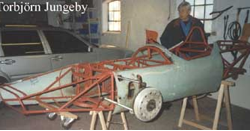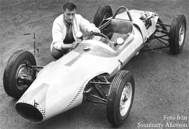SPIDER
Spider FJ
In 1962 and 1963 Swede Svenharry Åkesson produced two BMC-engined formula juniors of up-to-date design, the Spider Mk I and Mk II. He followed up in 1965 with the formula 3 Spider Mk III.
Actually, his first Formula Junior project started in 1960 based on a frame made by Axel “Acke” Johansson (builder of the IFA aka Cooper-IFA aka Cooper-Wartburg formula junior car) and copied from a Cooper Mk 12 F3/500. Åkesson did however not finish this car, since he suspected it would end up being too heavy. As can be seen from the picture below, transmission was intended to be through a Volkswagen gearbox complete with swing axles.
Aborted 1959 formula junior project. (photo Svenharry Åkesson)
Spider Mk I
Svenharry Åkesson inspecting the remains of the MK I a couple of years ago (photo Torbjörn Jungeby)
In 1961, inspired by a visit to that year’s Racing Car Show, Åkesson started designing his Spider Mk I. The Mk I had a space frame, aluminium body, drum brakes from Fiat 1100 and a 1 litre BMC ‘A’ engine driving through a Volkswagen gearbox. Suspension followed normal practice of the day with outboard springs/dampers. Weight was targeted at 360 kgs because of the 1 litre engine.
Once the initial problem of finding a garage where to build the car was overcome construction started in October 1961. Two frames were built, one for Åkesson and the other for the garage owner. However, only Åkesson’s car was finished. It made its debut in a hillclimb in June 1962 (Röfors in Sweden) but Åkesson had to retire after the gearbox stuck in 1st gear after the start of the first run. The gear selection problems were difficult to solve and the car was only raced two more times in two ice races early 1963. Instead Åkesson raced his Elva 100, which he found more reliable. Plans were already underway for the Spider Mk II, and the Mk I was sold to a scrapyard. The car was, however, never broken up but rather the scrapyard owner used it playing around inside the fence of the yard… Since then frame and bodywork have passed through many owners over the years, but are still around at the time of writing (July 2010).
Spider Mk II
Like the Mk I, the Mk II specification comprised a space frame, aluminium body and an SU equipped BMC ‘A’ engine of 1 litre driving through a Volkswagen gearbox. The new car was both narrower and lower than its predecessor, but generally of a conventional design with outboard springs/dampers. This time the question of where to build the car was solved by being allowed to use the facilities of the vocational school where Åkesson was working as teacher.
The Mk II (photo Svenharry Åkesson)
The Mk II was finished in time for the Swedish 1963 summer season, but was not a rousing success resultwise, one reason might have been the use of a BMC engine when the competition mostly used Ford. Its competitiveness was probably also not improved by the use of standard VW ratios in the gearbox, but at least its handling on the road was excellent. Åkesson continued racing the car through the 1964 Swedish ice racing and summer seasons, where formula juniors were allowed to continue to compete in the F2 class. The car had now been uprated with a brand new Speedwell tuned 997 cc BMC A engine and Hewland gears in the VW gearbox. Further, it had been converted to disc brakes stemming from Triumph Spitfire up front and BMC Cooper at the rear.
For 1965, however the national races would be for F3 and Åkesson therefore started work on a new car, the Mk III formula 3, which continued the trend of being even lower and more narrow than its predecessor. The Mk II had to act as a donor for the engine, gearbox and master cylinders. Åkesson recovered the remains of the MK II a number of years ago, and has now finished a ground up restoration returning the car to its original drum brake configuration.




